Maureen Brewster
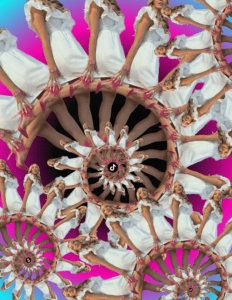
“’It’s Not Just About the Outfits’: Fashioning Gender, Race, and Class on #RushTok”
From 2021-2022, many TikTok users who participate in primary recruitment for sororities used outfit of the day (OOTD) videos to share what they are wearing, typically using the hashtag “#RushTok.” These videos name the brands and retailers for each garment and share each potential new member’s (PNM) recruitment experiences. This paper analyzes 2022 OOTD content on RushTok to consider how the style-fashion-dress and social media practices in this digital sociality intra-act (Barad, 2007) to (re)produce gender, race, and class norms in historically White sororities. I use feminist virtual ethnography to collect and explore 97 OOTD videos produced by PNMs during the 2022 Panhellenic sorority recruitment cycle. I follow the “sorority girl” around (Ahmed, 2010, 2017) in this data, looking for resonances in her appearance and effects. Firstly, RushTok OOTDs remediate gestural and communication practices from earlier forms of fashion media. I also find that RushTok style-fashion-dress practices emphasize luxury branding, highly feminine but conservative clothing styles, and bodily discipline. These are (re)shaped by spatial and algorithmic logics, which privilege enactments of the sorority girl that (re)produce the Panhellenic ideal of Whiteness, wealth, and cisfemininity. Ultimately, I argue that the racializing logics of White sororities intra-act with the TikTok algorithm to make this idealized sorority girl more visible, further (re)producing racialized, gendered, and classed hierarchies of difference.
Presenter Bio
Maureen Lehto Brewster is an Assistant Professor of Fashion Merchandising and Design at the University of Maryland Eastern Shore. She has a PhD in International Merchandising from the University of Georgia, where she studied the fashion and social media practices of Panhellenic sorority members. Maureen’s research explores how (micro)celebrity culture and social media matter in the fashion industry, specifically focusing on the (in)visibility and impact of race, class, gender, and sexuality in these contexts.
Brian Centrone
 Advertisement: “King of the Campus!” Merrimack Durbar Corduroy, Men’s Wear, A Fairchild Publication, Aug 24, 1951, pg. 96.
Advertisement: “King of the Campus!” Merrimack Durbar Corduroy, Men’s Wear, A Fairchild Publication, Aug 24, 1951, pg. 96.
“The College Trade: The Selling and Marketing of ‘America’s Best Dressed’ College Men”
In June of 1934, KOH-I-NOOR took out a double page ad for their Kover-Zip concealed zipper in Fairchild Publication’s Men’s Wear – Chicago Apparel Gazette Edition. The ad featured endorsements from ten of the “best dressed” college men attending esteemed American universities. This was not the first ad to target the college trade in this way, but it was one of the most prominent. During a decade which saw an enrollment surge at American colleges and universities, the Kover-Zip ad serves as a reflection of the growing appeal of “Joe College” and his direct influence on the growth of the college trade throughout the 1930s. This paper aims to reveal how the rise in popularity of Joe College led to a flourishing of the college trade, and how that industry harvested, manipulated, and marketed his appeal and influence to sell men’s furnishings throughout the 20th century. This exploration will show how the men’s furnishings industry moved from “selling to” to the “selling of” America’s best dressed college men trough pointed ads that shaped consumer identity and directed their purchasing power. This paper further aims to showcase the history of the college trade business, from its simple marketing at the beginning of the 20th century; rise in prominence in the 1930s; plunge during the war years; post war boom; decline as the relevance of Joe College waned at the end of the 1960s; to the reemergence of IVY and preppy style at the turn of the century. This paper will pull from almost a century of college trade marketing and advertisements in Fairchild’s Men’s Wear; historic newspaper reports on the college trade’s influence on men’s fashion; scholarship on 20th century men’s fashion, the history and significance of Joe College, and social, economic, and political issues that impacted college men and fashion.
Presenter Bio
Brian Centrone has an MA in Costume Studies from New York University where he wrote his thesis on the significance of the men’s trouser crease in the late nineteenth century. He has presented at the Richard Martin Symposium, The Association of Dress Historians New Research Conference, EUPOP, CSA, and others. His research has appeared in Threads magazine, the FIDM Museum Blog, the FIT Fashion History Timeline, the Bloomsbury Encyclopedia of Film and Television Costume Design (forthcoming), and Intellect’s Fashion, Style, and Popular Culture journal. His exhibition and book reviews have appeared in Dress and The Journal of Dress History, respectively.
Maria Chammah
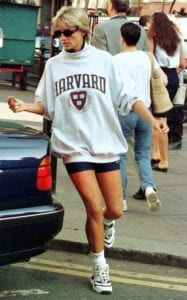 PH. Kieran Doherty/Reuters “”The Crimson sweatshirt was all about style and had nothing to do with university spirit
PH. Kieran Doherty/Reuters “”The Crimson sweatshirt was all about style and had nothing to do with university spirit
“The Harvard Sweatshirt: Too Cool for School”
Princess Diana had an affection for pairing sweatshirts with biker shorts. One of the most iconic was a cowl-neck Harvard crewneck she often wore to the gym. This piece was so critical that the Ivy League university recreated it for season 5 of The Crown after the costume department reached out. Princess Diana in 1997 and her character in The Crown in 2022 launched and relaunched a fashion for the Crimson sweatshirt that had nothing to do with university spirit and was all about style. On the one hand, historically, university sports fans and students wear university-related clothing to connect with their institutions and their sports teams and show their identity and spirit. Conversely, collegiate clothing plays a significant role in building university brands and reputations. During the 20th century, university brands and reputations became part of the “All American” vernacular that flooded popular culture becoming a compelling component of the identity of American fashion. Although it is customary to trope American Fashion to Hollywood and Seventh Avenue, college students have been key players in the development of a casual style that is the epitome of American Style. Drawing on Bourdieu’s ideas of social space, acknowledging the impact of media and mass culture in structuring the fashion field, and Marx’s ideas of commoditization and fashion fetishism, this article explores the Harvard sweatshirt’s road from school to cool. It will explain how and when the item transubstantiated from a signifier of class privilege and intelligence to a signifier of style and became part of the spectacle of fashion. In addition, it will describe how the institution capitalized on this phenomenon and directly affected the inhabitants of the social space that is Harvard University and other like universities that have followed Harvard’s path.
Presenter Bio
Maria Chammah is a second-year Costume Studies MA student at NYU. Passionate about fashion and street style, its social and cultural analysis in different places and times, and its correspondence with film, music, and art. Her research includes high-voltage fashion elements through history, like white lace collars in the 1660s, yellow in the 19th century, the handkerchief in the 1930s, and bold colors in the post-pandemic world. Maria is Argentinean and has lived and worked in Paris, Milan, and New York. She worked in the industry as a photo producer and a stylist for world-renowned clients.
Deirdre Clemente
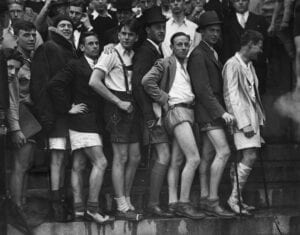 The men of Dartmouth University staged an on-campus protest in 1930 to encourage the wearing of shorts. The menswear industry took notice.
The men of Dartmouth University staged an on-campus protest in 1930 to encourage the wearing of shorts. The menswear industry took notice.
“From Dormitories to Department Stores: Collegians as Creators and Consumers of American Fashion”
The legacy of collegians is all around us: the crewneck sweater; khakis; flip flops, shorts; jeans; shorts; and ballet flats. How garments popularized on campus got from dormitories to department stores tells us much about the development of the American fashion industry. This primary source-rich presentation identifies how manufacturers and retailers came to understand the nascent collegiate market in the first half of the twentieth century—a time when enrollments grew by more than sixfold. The college campus was fertile ground, and everyone wanted a piece. Even those who didn’t go to college, wanted to dress like they did—high school kids, office workers, and those called “young marrieds.” To cash in, Chicago powerhouse Marshall Fields solicited student designs. Campus Originals Guild produced black gloves with notes from Beethoven’s Fifth stitched in white—a design by Mimi Dworsky, Vassar Class of 1942. Trend scouts lurked on campus. “It’s hardly worth it to appear in presentable garb,” a Princeton student snipped in 1936. “If he does, a dapper gentleman with a camera pops out, snaps a quick photo, and he finds himself in the style magazines or in clothing advertisements.” Drawing from archival sources at 15 college campuses, this presentation celebrates the central role that collegians have played in making the American wardrobe.
Presenter Bio
Deirdre Clemente is a scholar of the American fashion industry and studies dress as social and cultural change. She is the author of Dress Casual: How College Students Redefined American Style, which looks at collegians as the driving force behind the “casualization” of the American wardrobe. Dr. Clemente’s work has been profiled in The New York Times, The Washington Post, The Wall Street Journal, GQ, The Atlantic, Women’s Wear Daily, and Harper’s Bazaar.
Daniel James Cole
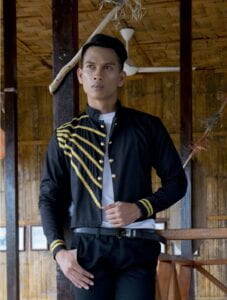
In 2017, Fashion Design students at Cosmopoint University in Kota Kinabalu, Sabah (Borneo) Malaysia, were assigned to create a garment inspired by the traditional dress of the region as part of their senior collection. This presentation explores the assignment
and the cultural and political context in which the projects were created.
“Tradition is Trending: Regional Inspiration in the fashion curriculum in Sabah”
During the spring semester of 2017 at the Kota Kinabalu campus of Cosmopoint International College of Technology, lecturer Madam Yana Harun posed a challenging requirement for her graduating students’ senior capstone project. The students were assigned to create garments in three categories as their final semesters work to exemplify the teaching they had received in the previous courses at the college; one of these themes was to create a garment or garments inspired by the regional ethnic dress of North Borneo but for the contemporary market. In giving this assignment, Harun was actually tapping a developing market in the region. Culture-based pageants for women had begun in 1960 and developed markedly in the decades since, with organized men’s pageants developing during the 2000s. During the 2010s, both the male and the female pageants began including – in addition to the established traditional dress and the Western evening dress – the type of hybrid styles that Harun was assigning in her class. At this time, two of Harun’s students were interviewed by the author as part of a larger study of contemporization of traditional dress; these two students were Asraf Ajmain, and Aileen Lim. Both had completed multiple pieces within the guidelines of the updated traditional theme. One of Ajmain’s looks involved a deconstructed interpretation of the regional man’s black guang jacket combining formal tribal dress, British colonialism, and his own contemporary aesthetic. Lim’s pieces included an evening gown inspired by the local traditional man’s turban, the sigar, including the indigenous supplementary-weft textile, kain dastar, and received prominent placement in Borneo Fashion Week in the following months. Since their graduation, Ajmain and Lim have continued to work in fashion in the city with steady success; for both, this hybrid style of clothing assigned in their senior project has been a cornerstone of their output since.
Presenter Bio
Daniel James Cole is adjunct faculty at New York University Costume Studies, and adjunct assistant professor at Fashion Institute of Technology. He is co-author, with Nancy Deihl, of The History of Modern Fashion (2015) and a contributing author to The Hidden History of American Fashion (2018). Daniel has also published in Critical Studies in Men’s Fashion (Intellect), Persuasions (The Jane Austen Society of North America), SearchMode (Ecole de la mode) and several times in the journal of the International Foundation of Fashion Technology Institutes. His fieldwork in Borneo with research grants from NYU Steinhardt School, Fashion Institute of Technology, and the Costume Society of America has been supported by the governments of both Malaysian and Indonesia.
Jacqueline Field
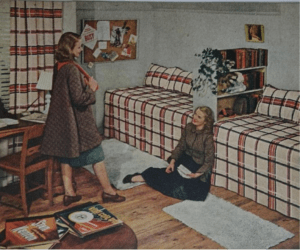
Students say matched sets of Bates bedspreads and draperies are as essential as textbooks. Bates back to school advertisement, mid-1940s. Bates archive courtesy of Maine MILL.
“Collegians Help Bates Fabrics Select ‘Back to School’ Styles”
For many college students the worry about going back to school looking “right” and “fitting in” came to hinge as much, if not more, on having the “right” fashionable dorm bed cover as wearing the “right” clothes. Such was the outcome of the strategy Bates Fabrics devised to capture the post WW II college student back to school market. To that end in 1942 Bates, the world’s largest jacquard bedcover manufacturer, established the practice of nationally recruiting an annual advisory group of outstanding students, known as the Bates College Board. The Board’s assigned task was to survey and identify college student design preferences for dorm bedspreads and fashion fabrics. The information guided Bates Fabrics manufacturing decisions ensuring new designs met current student taste and would sell well. Researched in the company’s partially surviving archive this paper explores Bates Fabrics back to school jacquard designs and garment fabrics, their marketing, and the Bates College Board’s level of involvement. In one instance late 1940s sophisticated colored back to school advertisements featured male and female College Board members modelling Bates Campus Approved clothing respectively posed in smart dorm room settings with latest design room-mate matching pairs of Bates bedspreads. By the mid-1950s the “back to school” season brought a national blitz of Bates Fabrics aggressive newspaper, magazine, and TV advertising, store window and in-store displays promoting the year’s college spread designs and clothing with the Bates Campus Approved and Bates Campus Tested labels. Coast to coast, more than 3,000 stores were pleased to tie in with the Bates Fabrics back to school program that generated the sector’s biggest and most profitable sales of the year. A Bates bedspread was largely considered a back to school “must have”. Into the 1960s back to school was dominated by Bates bedwear, fabrics, and fashions designed for college and approved by students.
Presenter Bio
Jacqueline Field is a textile and dress historian. She formerly taught and was Costume Curator at Westbrook College, Portland, Maine. She served on the CSA National Board. Recently she authored the Historic Dress Collection narrative and site overview for Maine Historical Society’s MMN portal, and contributed to MHS (2022) costume exhibition Northern Threads. She authored Textiles and Designs: Bates Mill 1930-1990, (2020), and co-authored the award- winning American Silk 1830-1930, (2007). A graduate of Edinburgh College of Art (Scotland), she received her M.A. in American and New England Studies (Material Culture) from the University of Southern Maine.
Sarah Gilligan
 Keanu Reeves at the London film premiere of John Wick 4. March 2023.
Keanu Reeves at the London film premiere of John Wick 4. March 2023.
“‘The hottest professor on campus’: Keanu Reeves, Dark Academia and fashioning ageing masculinity on the red carpet”
In March 2023, Keanu Reeves appeared on the red carpet adorned in an olive corduroy suit by Italian fashion brand Boglioli for the London premiere of John Wick 4. In their coverage, fashion bloggers Tom and Lorenzo posited that Reeves was ‘dressed like the hottest professor on campus’ (2023). With his long hair, beard and suit, Reeves’ look disrupted the sartorial expectations of the red carpet as a ‘pseudo-event’(Boorstin 2012). In refuting the gendered conventions of ‘red carpet labour’ (Lawson and Draper 2021), the studied nonchalance of the ageing star-celebrity evoked the modernity of the mid-century Ivy League aesthetic. Adopting an interdisciplinary approach drawing from critical work in fashion, film and cultural studies, this paper will offer a close textual analysis of Reeves’ look on and beyond the red carpet. I will argue that Reeves’ styling at the premiere borrows both from Ivy League style as a privileged expression of American WASP masculinity, and speaks to the Gen Z viral aesthetic of Dark Academia (Nothmann 2023; Murray 2023;). Reeves’ performative adoption of the Dark Academia / hot professor aesthetic functions to maximise his enduring brand value as a star-celebrity commodity with cross-generational appeal. In intersecting and diverging from his on-screen persona as John Wick, Reeves becomes reduced to a ‘metamodern’ (Akker and Vermeulen 2017; 2010; Gerrie 2020) spectacle of surfaces that evokes nostalgia for an imagined and eroticised, yet vulnerable fashioning of ageing masculinity.
Presenter Bio
Dr Sarah Gilligan is an Assistant Professor (Senior Lecturer) in Fashion Communication in the School of Design at Northumbria University (UK). Her research and publications centre on screen costuming, fashion and identities in contemporary visual cultures, especially cinema, TV drama and photography with articles in Fashion Theory and Film, Fashion and Consumption, together with chapters for a range of edited collections. Sarah is the co-founder of the international Fashion, Costume and Visual Cultures (FCVC) Network and has recently guest edited special issues of Clothing Cultures (6.1), Critical Studies in Men’s Fashion (7.1-2) and Queer Studies in Media and Popular Culture (5.2-3).
Sara Idacavage
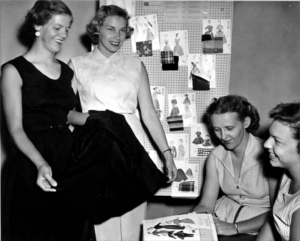 Georgia Cooperative Extension Service Pictures, Hargrett Rare Book and Manuscript Library, The University of Georgia Libraries
Georgia Cooperative Extension Service Pictures, Hargrett Rare Book and Manuscript Library, The University of Georgia Libraries
“Beyond the Sewing Machine: What Can the Home Economics Movement Contribute to Pedagogies of the Present?”
Fashion education in the United States can be traced back to the home economics movement, which was established to improve the social, economic, and psychological well-being of individuals, families, and communities through research and education. However, partly due to its emphasis on household work, the movement’s contributions to the fashion industry have been largely overlooked. 1 Examining the history of home economics as a discipline demonstrates shifts in how fashion has been practiced and analyzed in higher education and for what purposes, leading to critical questions around fashion education today. Starting in the 1890s, first-generation home economists were concerned with helping women clothe their families as efficiently and economically as possible through curriculum that covered sewing, mending, laundering, clothing selection, and fabric composition. In line with the modern concepts of “sustainable” and “slow” fashion, home economists were driven by consumer activism and advocated for businesses to produce high-quality yet reasonably priced goods, for consumers to make systematic purchasing decisions based on long-term benefits and personal needs, and for governments to take action to protect both consumers and garment workers. 2 The current state of fashion education in the United States looks very different than it did during the origins of the home economics movement, coinciding with changing attitudes about gender roles, the rise of neoliberalist ideologies, and shifts in clothing production from households to foreign factories. In tandem with these changes, the educational mission of clothing and textile programs has shifted from teaching skills to meet the needs of families to training students for careers in order to maximize the profits of businesses. 3 Through a content analysis of home economics textbooks published between the 1910s and 1960s, this paper questions what today’s fashion educators can learn from the history of the home economics movement in order to generate fashion curriculum that is centered around conscientious consumerism and caring for others.
Presenter Bio
Sara Idacavage holds a master’s degree in Fashion Studies from Parsons School of Design and a bachelor’s degree in Fashion Merchandising from the University of Georgia, where she is currently a doctoral candidate in the Department of Textiles, Merchandising, and Interiors. Her research examines how fashion education can be enhanced by using sustainability to frame historical inquiry, placing unsustainable ideas and practices within a broader historical context and encouraging a problem-oriented approach to fashion history. Sara previously taught courses on fashion history, theory, and textiles at the Pratt Institute, the Fashion Institute of Technology, and Parsons School of Design.
Jonathan Lee

Zhang, Zeduan. Qingming Shanghe Tu (Along the River during Qingming Festival). C. 12th century. The British Museum, https://www.britishmuseum.org/collection/image/274745001
“The East Asian Fashion Curriculum Framework: A Proposal – for fashion design programs in higher education”
This project proposes a curriculum framework of East Asian fashion discourses in fashion design programs at an undergraduate level. Amidst the learning environment in higher education that is Eurocentric, Anglophone, white-dominated, and colonial, the convention of the education system easily and unnoticeably seeded the conception that only Western knowledge is academically valuable (Baker 8). I experienced the underlying coloniality in higher education in fashion while I was studying for my bachelor’s degree in fashion design at Toronto Metropolitan University (TMU). In my current Graduate studies, I have found the motivation to pursue a career in higher education teaching. While this curriculum proposal resists traditional Western notions of fashion design education and centers decolonization and East Asian representation in Western education system, it also lays foundation for my pedagogical ideology in the prospect future. This project uses the fashion curriculum at TMU as a case study to unpack the discourse of coloniality in fashion education. The former Chair of Fashion at TMU, Ben Barry, put forward the three guiding principles of inclusion, decolonization, and sustainability as the pedagogy to be implemented for all the courses (Barry 124). With reference to the manifesto Barry proposed, this project aims to raise racial and cultural awareness and promote the representation of East Asian students. Therefore, with the inclusion of affect and decolonization theories in fashion education, as well as my positionality as a young East Asian scholar, this project will showcase a prototype of a pair of undergraduate introductory-level fashion courses Art History of East Asia I and II, to foreground my proposal of the East Asian fashion curriculum at fashion schools. Subsequently, this project will bring forward the future implication of how to promote the East Asian fashion curriculum to institutions beyond TMU.
Presenter Bio
Jonathan Lee is a first-year student in the MA Fashion program at Toronto Metropolitan University (TMU) and a fashion designer. Having graduated from the Undergraduate Fashion Design program at TMU, he decided to continue pursuing his academic craving for a theoretical approach to fashion. He is interested in exploring East Asian fashion discourses through the lens of decolonization and cultural studies. His current directional research will focus on the ethnocultural identity and diaspora of Hongkongers through a lens of fashion and how it contributes to the Hong Kong taste of fashion as a unique cultural entity.
Reina Lewis
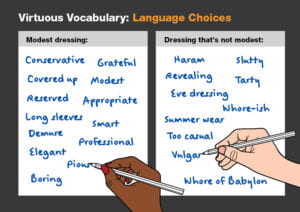
Staff development training exercise: Modest Workwear: the organisational impact of dress & appearance, Reina Lewis & Kristin Aune.
“Is Fashion Secular? Belief, worldview, and religious diversity in fashion education”
Fashion has been informed by and in the service of religion and belief around the world for centuries. Yet the contemporary ‘western’ globalized fashion industry continues to regard itself as default secular, with religion relegated to artistic ‘inspiration’. This despite that the industry is populated by people of faith and belief (including in the western European presumed heartlands of couture) and reaches consumers of diverse religions and worldviews (including in so-called ‘emerging markets’). In scholarship, religion and fashion still find it difficult to ‘talk’ to each other (outside the domain of ethnography): fashion scholars generally neglect religion, belief, and worldview and religion scholars mainly neglect dress. This has significant implication for fashion education in terms of curricula, especially in relation to current moves to decolonise education, and also for recruitment of students and for staff recruitment, progression, and retention. (And by staff, I mean everyone working in fashion education, not only faculty.) With the fashion industry, fashion media, and fashion education under pressure to diversify, my paper investigates the risks and intersectional consequences of a sectoral aversion to regarding religion and belief as part of the fashion eco-system.
Presenter Bio
Reina Lewis is Centenary Professor of Cultural Studies at London College of Fashion, UAL. Her books include: Muslim Fashion: Contemporary Style Cultures (2015); Styling South Asian Youth Cultures: Fashion, Media, Society (ed. 2018 with Lipi Begum and Rohit K. Dasgupta); Modest Fashion: Styling Bodies, Mediating Faith, (ed. 2013); The Poetics and Politics of Place: Ottoman Istanbul and British Orientalism (ed. 2010 with Zeynep Inankur and Mary Roberts); Gender, Modernity and Liberty: Middle Eastern and Western Women’s Writings: A Critical Reader (ed. 2006 with Nancy Micklewright); Rethinking Orientalism: Women, Travel and the Ottoman Harem (2004): Feminist Postcolonial Theory: A Reader (ed. 2003 with Sara Mills); Gendering Orientalism: Race, Femininity and Representation (1996); and Outlooks: Lesbian and Gay Visual Cultures (ed.1996 with Peter Horne). Reina was consulting curator for the exhibition Contemporary Muslim Fashions, at the Fine Art Museums of San Francisco in 2018 (touring Frankfurt 2019, Cooper Hewitt Smithsonian Design Museum 2020) and is co-editor of the accompanying book with Jill D’Allesandro.
Charles McFarlane
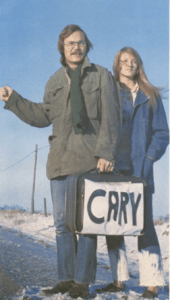 Two students from Northern Illinois University. Source: NIU Norther, 1970.
Two students from Northern Illinois University. Source: NIU Norther, 1970.
The Influence of Military Surplus Clothing on the American Collegiate Style 1945-1972
Military uniform design and fashion have long borrowed from each other. Military-inspired garments are commonplace, from mall brands to high-street boutiques. Nearly every designer or brand has done a take on a military field jacket, fatigue trousers, or even more generally, camouflage. How military uniforms became so intertwined in popular fashion started on college campuses. In the post World War II years, the style of the American college student was both big business and the place where mainstream American fashion would be born. Bubbling up from dorms, classrooms, and quads, new styles of dress gained acceptance and spread into the mainstream. This research charts how these uniforms grew to be accepted and common on American college campuses in the decades after WWII. In the immediate postwar period, military uniforms entered the civilian fashion system through returning veterans, many of them new college students, who incorporated their old uniforms into their wardrobes. In the 1960s, military uniforms became a key part of the counter-culture youth style and became forever associated with the anti-Vietnam war movement and campus protests. The 1960s would recast military surplus clothing as rebellious, with students coopting uniforms looking to disengage from capitalist consumption, outdoor enthusiasts, and students militantly organizing against the Vietnam War. College students from the 1940s through the 1960s would break the link between
these garments and the military they were designed to dress, appropriating and decontextualizing them. While wearing Army surplus is far from subversive now, it was college students of the postwar period who brought military surplus fully into mainstream popular fashion. We owe the place of military surplus and inspired design in fashion to college students. Military uniforms are as much a part of American fashion as blue jeans and tennis sneakers.
Presenter Bio
Charles McFarlane is a fashion historian and researcher, focusing on the intersection of military uniforms and popular fashion. He holds an MA in Costume Studies from New York University, where his thesis, Combat Threads: How WWII Changed Uniforms and Became a Staple of American Popular Fashion, examined the important role military uniforms have played in American popular fashion. His research focuses on the intersection of 20th and 21st-century military uniforms and everyday fashion, the semiotics of military uniforms, as well as the soldier as a consumer of fashion. His writing has appeared in outlets such as Monocle, GQ.com, and New Lines Magazine. He lives in Brooklyn, New York.
Eleanor O’Neill
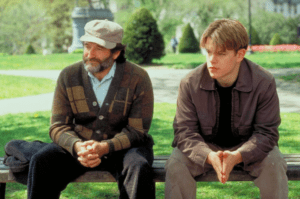 Still from Good Will Hunting (1997), Van Sant (Director) (53:03)
Still from Good Will Hunting (1997), Van Sant (Director) (53:03)
“Knitting as ‘Other’: Costume and identity on college campuses”
Knitting is an innovative textile design process, playing a key role in ground-breaking developments in apparel and textile manufacture (McQuaid and Beesley 2005; Smith and Moore 2019). Despite this however, knitting carries with it a certain stigma. Firmly embedded in narratives of femininity, domesticity and nostalgia, knitting often remains understood as a ‘highly gendered relic from yesteryear’ (Turney 2009: 5). Through the analysis of a key piece of knitwear worn by Sean Maguire, a therapist portrayed by Robin Williams in the film Good Will Hunting (1997), this paper will explore the role of costume in upholding these narratives whilst simultaneously perpetuating gender ideals. Discourse analysis allows for the analysis of ideas, concepts and transactions that exist in-between and around material things. It is therefore concerned with meaning-making processes and how and why meaning is formed (Bergström and Boréus 2017: 214). Michel Foucault, a key figure in the development of discourse analysis, describes discourse as ‘practices that systematically form the objects of which they speak’ (1972: 49), suggesting that objects have no meaning without discourse. In this way discourses construct social reality. The more a particular reading is suggested, the more embedded it becomes in the public psyche and consequently, a knitted garment’s location in contemporary culture and society continues to be reinforced. As a methodology made up of a bricolage of methods, this paper considers costume analysis as an informant of broader discourse analysis. By analyzing the role of a knitted garment in the communication of identity on screen, this paper will highlight how a limited and specific narrative about knitting continues to endure. Ultimately, the paper aims to suggest that the effects of such narratives also permeate the study of this creative discipline on design school campuses today, resulting in this creative and innovative discipline remaining understudied and underinvested.
Presenter Bio
Eleanor O’Neill is a lecturer in the Fashion department at Northumbria University in the UK. Her academic interests are centered around understanding how material knowledge surrounding craft disciplines is valued in 21st-century society. Her research focuses on the narratives surrounding knitting as a discipline in contemporary culture and how they influence public understanding of this creative practice and its uses. Through her research, she seeks to understand how these narratives are communicated and maintained through everyday discourse. The aim of her research is to encourage a repositioning of knitting as a valuable way of making across diverse disciplines. Her latest paper Knitting: The Destructive Yarn-Bomb can be found in TEXTILE Journal of Cloth and Culture.
Victoria Rose Pass
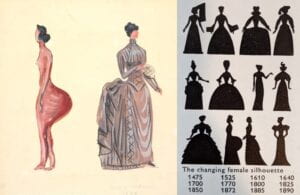
Left: Bernard Rudofsky, 1886 Tennis Costume, 1944; Gouache on paper; Right: Illustration by Ebbe Sunesen in R. Broby Johansen, Body and Clothes: An Illustrated History of Costume, 1968
“Anti-Fashion Histories Constructing Modern Whiteness”
This paper will explore the after-life of nineteenth-century dress reform ideas in the mid-twentieth century through the work of Bernard Rudofsky, an Austrian-American architect, designer, and writer, and Rudolf Broby-Johansen, a Danish poet, writer, and communist activist. Rudofsky curated the exhibition “Are Clothes Modern,” in 1944 at the Museum of Modern Art in New York. He published a catalog in 1947 and expanded it in the 1971 book The Unfashionable Human Body. Broby-Johansen published Body and Clothes: An Illustrated History of Costume in 1968. Through books and an exhibition the two aimed to teach a popular American audience about fashion history. Through lavish illustration and cross-cultural and trans-historical comparisons, they sought to expose fashion as oppressive and anti-modernist. They used some of the very same examples as earlier dress reformers, such as comparing ill-fitting Western shoes to the historical practice of foot binding in China, or likening corsets to various forms of body binding practiced all over the world. In this way, they replicate the racialized terms of nineteenth-century dress reformers who marked fashion as primitive and irrational through such comparisons. Both the nineteenth and twentieth-century texts reinforce and in fact, rely on the false narrative that non-Western dress is traditional and unchanging. In some ways the cross-cultural approach of the twentieth-century books is a compelling and more complex teaching tool, helping readers to understand the common uses of fashion across cultures: as uniforms, status symbols, to stimulate sexual attraction, etc… On the other hand, these more recent texts continue to use these comparisons to argue that Western fashion is retrograde. Close readings of these texts will illuminate constructions of historical narratives that are undergirded by the logic of social Darwinism and eugenics. Such readings help us to more critically interrogate the ways that issues of race can often hide in plain sight in fashion histories and the ways that modernity is often coded as white.
Presenter Bio
Victoria Rose Pass is an associate professor of fashion and design history at the Maryland Institute College of Art. Her essay “Racial Masquerades in the Magazines: Defining White Femininity Between the Wars,” was published in the Journal of Modern Periodical Studies in 2020. She has also co-edited two books, Design Beyond the Canon with Jennifer Kauffman-Buhler and Christopher Wilson (Bloomsbury 2019) and Women’s Magazines in Print and New Media with Noliwe Rooks and Ayana Weekley (Routledge 2016). Her writing has also appeared in Fashion, Style & Popular Culture, Omenka Magazine, and BmoreArt. She also shares her research on Instagram: @visualsustenance.
Anne Peirson-Smith
“Through a glass darkly: interrogating the meanings behind the Dark Academic style trend and its mythic and material manifestations”
This presentation interrogates the various iterations and motivations behind the Dark Academia style trend and dressing-up movement. Drawing inspiration in its textual poaching from literary and media sources whose plots are situated in universities and schools (i.e. Donna Tartt’s The Secret History, a tale of a menacing academic clique in Vermont and recently referenced in the fourth Netflix series of You), the dark academia trend embraces a mediated, mythic world of faux nostalgia. This brooding materialized fantasy is directed by aspirations for a classical, neo-liberal education guided by Greek and Latin language, canonical literary and poetry texts, Western European art, architecture, and fashion movements. The celebration and embodied performance of education and learning as a form of fantastic socialization and an elevating enterprise forms the core understanding of the movement with a fixation on illicit and quirky pursuits such as murder, cults, graveyard tours, secret gatherings, accompanied by ornate murderous props. Supposedly originating on Twitter in 2015, this fashion trend gained new followers during the Covid-19 lockdown and proliferated on TikTok. It manifested itself as a moody, preppy design aesthetic centered on blazers, trench coats, cloaks, culottes, kilts, tweeds, knitted waistcoats, long socks, loafers, DMs, and brogues, based on dark hues. The presentation will address the underlying motivations for dressing in this variegated style tribe and its heritage. It will examine the endless search for gratification through the colonization of mythic spaces by mimetically performing and masquerading in the process of constructing and deconstructing identities through dress as an expression of imagined selves. In addition, it will explore the darker side of the trend and its elitist, Western-centric tropes and lack of inclusivity which reflect a broader zeitgeist, while exploring the dangers and ironies of idealizing and romanticizing university life against the backdrop of a global academy under siege and in decline.
Presenter Bio
Anne Peirson-Smith, PhD is Professor of Fashion, School of Design, Northumbria University. She teaches and researches fashion studies, youth style, fashion marketing, and communication and has an industry background in branding and public relations. She has published numerous articles and book chapters on fashion and is associate editor of the Journal of Fashion, Style and Popular Culture (Intellect Books) and The Journal of Global Fashion Marketing. She co-authored Public Relations in Asia Pacific: Communicating Effectively Across Cultures (John Wiley, 2010); Global Fashion Brands: Style, Luxury & History (Intellect Books, 2014), Transglobal Fashion Narratives (Intellect Books: 2018); Planet Cosplay (2019) and The Fashion Business Reader (Berg/Fairchild Publishing 2019).
Lauren Downing Peters, Wiktoria Gawor and Sophia Klun
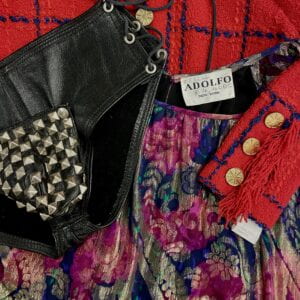 A closeup of faculty donations to the Fashion Study Collection, Columbia College Chicago. Photo courtesy of the author.
A closeup of faculty donations to the Fashion Study Collection, Columbia College Chicago. Photo courtesy of the author.
“Archive as Memory bank: Clothes and Collectors in the Fashion Study Collection”
There’s much that can be learned about a person by rifling through their wardrobe—from their favorite designers to their preferred textiles and silhouettes, to their body size and proportions, and even their favorite fragrances. Wardrobes are deeply personal amalgamations of not just garments, but of embodied memories and evolving, aspirational, and alternative identities. Whereas you can come to know someone quite intimately by studying the contents of their closet (indeed, this is the foundation of wardrobe studies), there is only so much that can ever be known about a person based on the self-conscious ways that they style themselves in public. This is, perhaps, particularly true for educators. Though norms for what constitutes “appropriate” academic garb have loosened over the years, lecturing is ultimately a performance—a performance of knowledge, of course, but also one of competency, compassion, and, in some cases, even coolness. And as with any performance, costuming is essential. While there are certainly exceptions, many educators adopt an on-campus “costume” or uniform that departs in ways both subtle and less so from their more private performances of self. Drawing upon personal wardrobes and individual garments—from polished Adolfo suiting to handmade assless chaps—donated to the Fashion Study Collection by Columbia College Chicago faculty, as well as photographs and interviews, this paper will explore how fashion educators navigate the private and the professorial in their self-fashioning practices. As the Director of the Fashion Study Collection, and thus the caretaker of these pieces, in this paper I will also consider when a wardrobe becomes a collection—that is, when the ordinary building blocks of everyday dress take on a character of their own and become something deserving of the care, space, and labor of fashion conservation.
Presenter Bio
Lauren Downing Peters, Ph.D., is Assistant Professor of Fashion Studies and Director of the Fashion Study Collection at Columbia College Chicago. Her interdisciplinary research focuses on plus-size fashion, histories of American fashion, the relationship between dress and the body, and transformed and inclusive fashion pedagogies. She is the author of Fashion Before Plus-Size: Bodies, Bias and the Birth of an Industry (2023), the co-editor with Hazel Clark of Fashion in American Life (2024), and the co-curator with Emma McClendon of the exhibition (Re-)Dressing the American Body at the Bard Graduate Center Gallery (2025).
Wiktoria Gawor is a senior undergraduate student majoring in Fashion Merchandising and minoring in Sustainable Fashion at Columbia College Chicago. She is the co-curator of a research exhibition on Guatemalan textiles titled, The Huipil: Art/Object, which was on display at the Columbia College Chicago Library during the spring of 2023. She co-presented this work at the Society for Textual Scholarship Conference at The New School in May 2023. Wiktoria has competed in the Fashion Scholarship Fund (FSF) and is currently competing in the National Retail Federation (NRF) University Challenge. Her research interests include fashion history, fashion archives, and fashion curation.
Sophia Klun is a junior undergraduate student at Columbia College Chicago majoring in Product Development and minoring in Sustainable Fashion. She is a research assistant at the Fashion Study Collection, practicing garment conservation methods, archival fashion research, and collaborating on fashion exhibitions. Sophia is also competing in the 2024 Fashion Scholarship Fund (FSF) case study competition as well as the 2023/24 National Retail Fund (NRF) University Challenge. Her research interests include archival fashion and exhibition, sustainable production methods, and fashion anthropology.
Ekua Sekyere and Patrick Taylor

2019: New Freshmen at Morehouse College don the infamous Morehouse dress shirts and ties, signifying a new school year.
“No Shades, No Sagging, No Do-Rags: How Dress Codes Reinforce Elitist Structures Within Academic Institutions”
By consenting to imposed dress codes dictating how we adorn our bodies, we accept and uphold privileges, reinforcing inherently limited notions of class, race, and gender. This paper will critically examine how pop culture, specifically hip-hop culture, impacts dress in higher education by exploring dress codes within Historically Black Colleges and Universities (HBCUs). Examining the link between “streetwear” and “Hip-Hop” related clothing has become intrinsic in determining different class levels within these educational spaces. This enforcement of Black elitist hierarchies highlights the problematic nature of respectability politics and its place within higher education.
By examining the prevalence of Black Elitism on HBCU campuses and the complex structures that reinforce racist concepts of class identity, we can interrogate how they uphold the notion that proximity to whiteness translates to proximity to propriety, reinforcing bourgeois ethos (Ford). We will be discussing how enforced dress codes are constructed to support elitism by drawing on a language of semiotics, limiting the individuality of the wearer, and perpetuating classist ideals of respectability and legitimacy. This uniformity is instrumental in producing docile bodies (Foucault) and upholding white supremacy.
Furthermore, by interpreting collegiate dress codes, we can expose how intrinsically gendered the dress codes are, reinforcing hegemonic ideals of masculinity and creating institutional barriers to gender non-conforming individuals, as explored in the Mean Girls of Morehouse case study (Mobley). By explicitly naming items of dress and limiting how they could be “appropriately worn,” the Morehouse dress codes implemented classist expectations upon the dress of their students—including but not limited to do-rags, sunglasses, or “shades” (without medical documentation to support use) and sagging pants (Ford).
Presenter Bio
Ekua is a Bachelor of Commerce graduate and current MA Fashion student at Toronto Metropolitan University. Her current research focuses on cultural appropriation within the fashion industry from a marketing and business perspective. She’s interested in examining how the implications of dress from throughout the African diaspora, music, and pop culture influence high fashion—additionally, exploring the impact of access to luxury goods within the fashion industry.
Patrick Taylor is a current MA Fashion student at Toronto Metropolitan University and is an exhibition and curation collections assistant in their Fashion Research Collection. His background is in Art History and Sociology, with fashion acting as the intersection of both areas of study. His studies primarily focus on material culture and the curation of historical garments, examining notions of autobiography and legacy creation through donated wardrobes.
Jenise Sileo
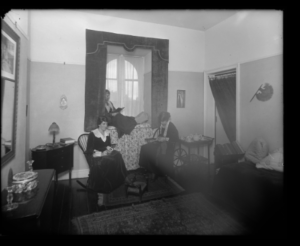
Three students in their dorm room, most likely in Main Building. Two are knitting while the other reads a book on a window seat.
“Fashion Knits: Natural, Subversive, and Style for Vassar College”
Founded in 1861, Vassar College was “a pioneer for women’s education and liberal arts,” (Vassar College, n.d.) and prided itself on offering advanced coursework in chemistry, math, and French, all of which were “taught by the leading scholars of the day.” (Vassar College, n.d.) Besides adhering to a rigorous academic schedule, the women of Vassar engaged in other extra recreational and social activities joined clubs, and knitted. For this paper, I investigated the diaries written by three graduates: Anne Page Brydon, 1922-1923, Frances M. Bromley, 1870-1877, and Helen Hartley Pease, 1915-1919. As college students, these women recorded their personal thoughts, opinions, and desires. As young knitters, they journaled their progress while working on their projects. Knitting was a natural means of supplementing their wardrobe and strengthening friendships, but also a subversive action that freed them from the rigid standards set by the academic and social worlds. Those fashion knits contributed to the Vassar College campus fashion and worked to develop the young students’ taste and style. Knitting addressed, what Georg Simmel wrote about the developmental stages of our soul, the “physiological basis of our being,” (Simmel 1957, 542) and at the same time, knitting also satisfied fashion’s “demand for social adaptation,” (Simmel 1957, 543), its “tendency towards imitation,” (Simmel 1957, 543) and its “desire for expedient personal activity.” (Simmel 1957, 543) Additionally, I examined a campus photograph depicting two students engaged in a knitting project, and I communicated with the Facebook group called Vassar Knitwits, the next generation of Vassar college knitters. References Simmel, Georg. 1957. “Fashion.” The American Journal of Sociology 62, no. 6 (May): 541-558. May, 1957. Vassar College. n.d. “About – History.” Vassar College. Accessed April 21, 2023. https://www.vassar.edu/about/history.
Presenter Bio
Jenise Sileo is a Librarian and Costume Designer who specializes in repurposing textiles into wearable art. She holds an MA from New York University in Costume Studies and an MLIS from Long Island University. Jenise’s gowns were showcased in the 2019 Southern Vermont Art Exhibit, Unusual Threads: Stitching Together the Future of Fashion. As a member of the Costume Society of America, she has presented on the Native American Plateau Beaded Bags at both the regional and annual symposiums. Jenise continues to conduct independent fashion research and enjoys volunteering her services at local house museums.
Dina Smith-Glaviana
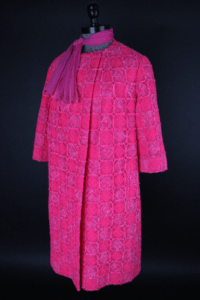 Coat, scarf, and hat worn together and donated by the collection’s founder, Oris Glisson.
Coat, scarf, and hat worn together and donated by the collection’s founder, Oris Glisson.
“The History of and Early Collecting Practices within the Oris Glisson Historic Costume and Textile Collection”
Like many university fashion collections, the Oris Glisson Historic Costume and Textile Collection at Virginia Tech, which bears the name of its founder was created in the mid-twentieth century to enhance teaching in home economics curricula. It was later formalized into a study collection as home economics programs transitioned into industry-focused clothing, textiles, and apparel programs (Green & Reddy-Best, 2022). Oris Glisson began significantly growing the collection’s holdings beginning in 1955, and the items she donated are considered the “hallmark” of the collection. However, the collection’s name, and the importance placed on the items she donated, often elicit questions about the founder-questions few can answer. Therefore, this research aimed to uncover the full history of the collection, learn more about its founder and understand how she shaped the collection during its formative years. A multi-methodological research approach was used to analyze data from 345 artifacts, five oral histories, and many historical documents relating to the collection and its founder. This research revealed that the collection represents Glisson’s contribution not only to the university where the collection is housed but to the field of clothing and textiles. Although she began her career as a professor of Home Economics in 1948, by 1960, Glisson had developed the university’s first clothing and textiles program, which was recognized as a model for education in the clothing and textiles field. This research also highlighted how founders might be key in shaping their collections. For example, artifact analysis revealed that Glisson focused on building volume while establishing the collection and was guided by her preference for high-end labels, which informed collecting practices until 2001 when new criteria for future collecting were established. Reference Green, D. N., & Reddy-Best, K. L. (2022). Curatorial reflections in North American university fashion collections: Challenging the canon. Critical Studies in Fashion & Beauty, 13(1), 7-20.
Presenter Bio
Dina Smith-Glaviana is an Assistant Professor of Fashion Merchandising and Design in the Department of Apparel, Housing, and Resource Management and Director of the Oris Glisson Historic Costume and Textile Collection at Virginia Polytechnic Institute and State University (VA Tech). Her research interests include dress and popular culture, subcultural dress and re-enactment, historic dress, and fashion collection digitization. She has published journal articles on science fiction and fantasy fan-themed apparel research, female Regency re-enactment dress, fashion history and merchandising pedagogy, and digital fashion exhibitions. She also produces creative and curatorial scholarship related to her re-enactment and digitization research.